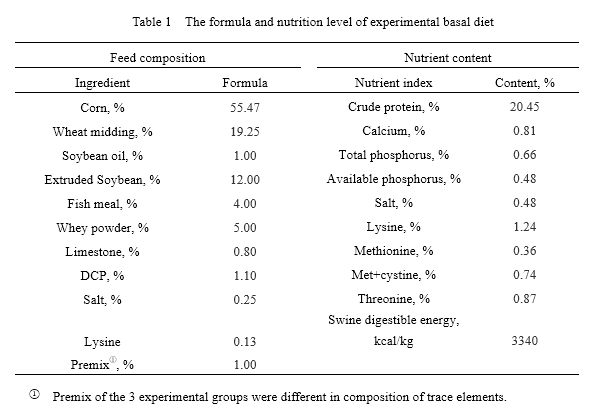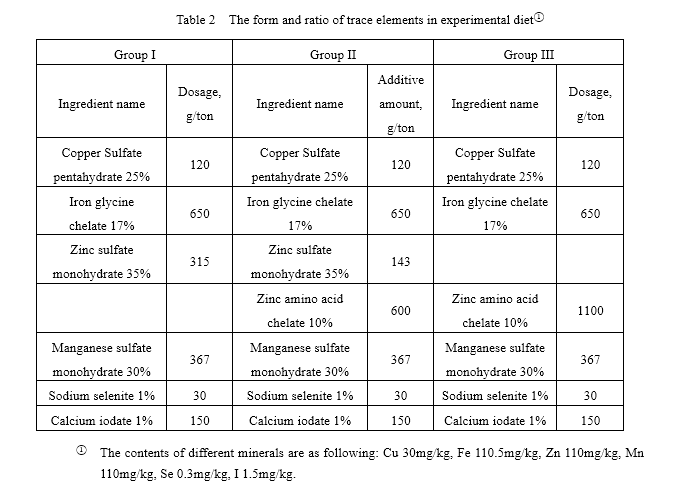Summary: A randomized block design experiment was conducted with 72 crossbred (Duroc × Landrace × Yorkshire) pigs (36 males and 36 females), all these piglets were randomly assigned to 3 triple-repeated treatment groups, there is totally 8 piglets with even sex in every repeat. Corn and soybean meal diet are applied to all 3 treatment groups and the formula of feed are same except for zinc. Group I was added 110mg/kg zinc of zinc sulfate monohydrate, group II was added 50mg/kg zinc of zinc sulfate monohydrate and 60mg/kg zinc of zinc amino acid chelate, Group III was added 110mg/kg zinc of zinc amino acid chelate. The experimental period was 28 days. The results showed that the 3 groups had no significant difference in piglets’ feed gain rate (P>0.05). The daily feed intake of Group II and Group III were improved respectively 4.6% and 9.8% than Group I, and had significant difference (P<0.05). The daily gain of Group II and Group I had no significant difference (P>0.05) , but the daily gain of Group III was increased 9.01% than Group I and had significant difference (P<0.05). The alkaline phosphatase (ALP) activity of Group II and Group III were improved respectively 6.3% and 10.4% than Group I, and had significant difference (P<0.05). The glutamic-pyruvic transaminase (GPT) activity of Group II and Group III were improved respectively 25.15% and 20.10% than Group I, and had significant difference (P<0.05). The zinc content in serum of Group II and Group III were improved respectively 64.9% and 145.8% than Group I, and had significant difference (P<0.05). And the content of immune globulin (IgG) in the 3 groups had no significant difference (P>0.05).
Keywords: trace minerals, zinc amino acid chelate, piglet, growth performance, chelated zinc for swine
Zinc amino acid chelate is a stable and effective amino acid chelate which is combined 1:1 mole ratio by many kinds of amino acid and soluble zinc. It is the three generation of new trace elements feed additives which contains zinc that can play zinc enzyme action in vivo, effectively remove free radicals, prevent lipid peroxidation, improve the ability of animals’ resist stress and strengthen the body immunity, and also has good effect on preventing skin dyskeratosis and promoting hair growth. The absorption utilization of organic zinc obviously better than inorganic zinc because that organic zinc has stable chemical properties and doesn’t react with substances such as lipid, cellulose, oxalic acid, phosphate, etc, to form undissolved compounds. Zinc amino acid chelate can be absorbed directly through the small intestinal in the gut, no antagonism between elements, and the biologicalvalue obviously higher than inorganic zinc.
This experiment studied the influence on reproductive performance and blood biochemical indicators of piglets about zinc amino acid chelate instead of zinc sulfate monohydrate. It provided reference for reasonable use of zinc in piglet feed.
1.Materials and Methods
1.1 Time and place
The experiment started in Peng Chang experimental basal piggery in Xiantao, Hubei on March 20th to April 20th, 2009.
1.2 Experimental animals and group
A randomized block design experiment was conducted with 72 crossbred (Duroc × Landrace × Yorkshire) pigs (36 males and 36 females), 24 pigs (12 of each sex) were assigned to each treatment, and treatment groups were assigned randomly to pens in 3 replications. Feeding 3 kinds of experiment diet respectively.
1.3 Experimental diet
The experiment was divided into 3 groups: 3 treatment groups all used corn and soybean meal diet which were same except the additive form of zinc. Group I added 110mg/kg zinc of zinc sulphate monohydrate. Group II added 50mg/kg zinc of zinc sulphate monohydrate plus 60mg/kg zinc of zinc amino acid chelate. Group III added 110mg/kg zinc of zinc amino acid chelate. The experimental period were 28 days. (Table 1 and Table 2)
All kinds of test feed were pressed for granular material.

1.4 Experimental materials
Zinc amino acid chelate, Iron glycine chelate: Produced by Wuhan Pharma Chemical Co., Ltd.
Other trace elements: from the market
1.5 Raising Management
The experimental period was total 30 days, 2 days as pilot treatment and 28 days as formal treatment. Experimental pigs were raised in the same piggery which was half open and double row type. Room temperature was kept in 25℃-28℃. Feed pigs 6 times each day in the first 2 weeks and 4 times in the later 2 weeks of the experiment. Piglets are freely to drink water. Kept piggery clean and disinfected twice a week.
Preparing work was finished in the afternoon before pilot experiment and the experiment began from the early morning. All piglets were fasting weighed before the experiment.
1.6 Experimental Index
1.6.1 Reproductive performance
Daily feed intake: collected the rest feed every morning before feeding.
Daily gain: weighed once a week for the average daily gain.
Feed gain rate: the average feed intake each week (kg) / the average daily gain each week (kg).
1.6.2 Blood biochemical indicator
Randomly chose two piglets of each block when the experiment was over, and drew blood respectively in anterior vena cava. Put blood into propylene coagutant tube, and then centrifugal separation serum, and stored specimen in refrigerators (-20℃) for use.
Determine the IgG content in serum with the method ELISA. The zinc content in serum is determined with ADVANJAJE brand ICP made by TDA company of USA, and the ALP activitiy of serum is determined by automatic biochemical analyzer (OLYMPUS-AU400), and the GPT activity is determined with HI-tach 7600-202.
1.7 Statistical analysis
After initial handling of experimental data by Excel, used software SPSS17.0 to do the variance analysis.
2.Results and Analysis
2.1 The influence on weaning piglets’ daily gain, feed intake and feed than gain about different zinc source
Analysed by table 3, the differences of feed gain rate of piglets in the 3 groups were not significant (P>0.05). The daily feed intake of Group II and Group III was improved 4.6% and 9.8% than Group I, and the differences were significant (P<0.05). There were no significant differences between Group II and Group I (P>0.05). And the daily gain of Group III was improved 9.01% than Group I (P<0.05).
2.2 The influence on piglets’ each biochemical index about different zinc source
It was clear that from table 4, APL activity in the serum of Group II and Group III were respectively improved 6.3% and 10.4% than Group I and had significant differences (P<0.05). The GPT activity of Group II and Group III respectively improved 25.15% and 20.10% than Group I and had significant differences (P<0.05). Zinc content in the serum of Group II and Group III respectively improved 64.9% and 145.8% than Group I and had significant differences (P<0.05). And Ig G content in the piglets’ serum of the 3 groups had no significant differences (P>0.05).
3.Conclusion
Trace mineral Zn participates in many metabolic processes, especially for maintaining cell’s structural integrity, activity and necessary function. They also play an important role in the animals’ prevention system. IgG is one of the main immunoglobulins in serum, which content reflect the body’s immune status, and zinc deficiency will drop animals’ immune function. In the experiment, adding Ig G content which of group zinc amino acid chelate and inorganic zinc + zinc amino acid chelate has an improve trend than group total inorganic zinc, but has no significant difference. It suggests that organic zinc may be good for piglets’ humoral immune.
ALP is one of the metal enzymes that contain zinc which molecule can catalyze the hydrolysis of phosphate as containing a couple of Zn. The activity is influenced easily on the condition of body’s zinc. Therefore, it also reflects nutritional status of zinc of animals’ body. Coffey (1994) reported that animals’ zinc deficiency would drop the ALP’s activity and zinc supplementation would rise it. Wei Zhang (2002) considered that ALP’s activity reflected the condition of zinc’s absorption and utilization of body’s. And it was better to use ALP’s activity as an identification evaluation to zinc’s utilization of single stomach animal. In the study, the proportion of different sources of zinc, organic zinc and inorganic zinc had an impact to ALP’s activity of weaning piglets’ serum.
Serum GPT is one of the strongest vitality transaminase in animals’ body at present which has an important position in animals’ amino acid metabolism. Yablanski (1986) reported that the activity of GOT, GPT, ALP in blood was positively related with landrace’s daily gain in normal physiological range. The GPT activity in piglets’ serum in Group II and Group III of the experiment were all in normal physiological range and higher than Group I. It was consistent with the result that piglets’ average daily gain of Group II and Group III were higher than Group I.
The zinc ion will feed into the blood when animals feed themselves, so zinc’s concentration in serum can reflect the absorption rate and utilization rate in a certain degree. The level of zinc in serum may use as an evaluation index of piglets’ nutrition under certain condition. Kornegay (1996) reported that piglets’ zinc deficiency would drop zinc’s content of serum and zinc supplementation would rise it, and what’s more, different source of zinc had an influence on zinc content of serum, and organic zinc could improve serums concentration of piglets better than zinc oxide. Matsui (1996), etc, found that adding 100mg/kg zinc amino aci chelate obviously higher than adding equal doses of zinc sulfate after determining zinc’s content of piglets’ femoral and serum. The research showed that different source of zinc had significant influence on zinc level of piglets in weaning piglets’ diet of 110mg/kg zinc supplementation. When zinc amino acid chelate provided 60mg/kg zinc and zinc sulfate provided 50mg/kg zinc, the zinc content of serum improved obviously than inorganic zinc. When zinc amino acid chelate provided 110mg/kg zinc, zinc content of serum improved 145.8% than control group. It verified that organic zinc could obviously improve zinc bioavailability and nutritional status of piglets.
The experimental summary: The addition of organic zinc not only can improve piglets’ feed intake and daily gain significantly, but also can improve piglets’ immunity and zinc bioavailability well.

